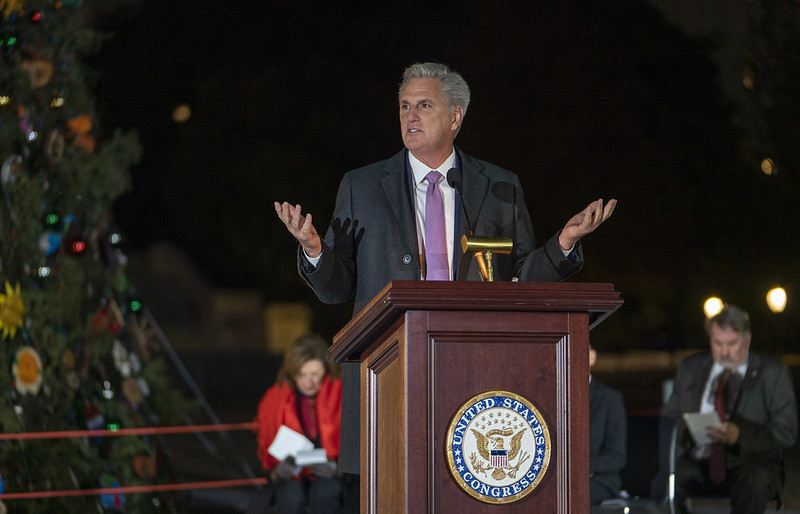
House Minority Leader Kevin McCarthy delivers remarks at the 2021 Capitol Christmas Tree lighting ceremony in Washington DC, December 1, 2021. USDA Forest Service photo by Tanya E. Flores.
The press wants Americans to think the fight in the GOP congressional caucus right now is about MAGA supporters vs. Leadership. Really, the fight is about the process of how American tax dollars get spent. At the Mises Institute, Connor O’Keeffe explains. And below, you can watch Rep. Matt Gaetz explain the fight in further detail in an appearance on the Timcast IRL podcast. O’Keeffe writes:
On Tuesday, Representative Kevin McCarthy (R-CA) was ousted as Speaker of the House. This came days after the former Speaker struck a forty-five-day spending deal with House Democrats to keep the government funded. The last-minute deal and successful motion to vacate are the latest acts in a weeks-long showdown between the former Speaker and Representative Matt Gaetz (R-FL).
The origin of this Gaetz-McCarthy showdown is a concession McCarthy and his allies made back in January to shore up the votes McCarthy needed to become House Speaker. According to CNN, the bloc agreed to “move 12 appropriations bills individually.” This was a major concession.
Traditionally, Congress would consider discretionary federal spending items on an issue-by-issue basis and then “appropriate” the funds for them. Under this system, the number of appropriations bills passed has to be equal to the number of subcommittees within the House and Senate Appropriations Committees. For more than a decade, that number has stood at twelve. Because of the 1974 Congressional Budget Act, the deadline for enacting these spending bills is always October 1. That means that, by law, Congress must pass twelve spending bills by October 1st to fund the government.
But Congress rarely meets the deadline. Because of this, congressional leaders have fallen back on two special types of spending bills—omnibus bills and continuing resolutions (CRs). Omnibus bills combine all twelve spending bills into one big package so that they’re all voted on at once. It’s a process that is supposed to be faster and more straightforward.
But even after eliminating most of the appropriations work, Congress has rarely approved the federal budget before the October 1 deadline. CRs are spending bills that also condense all federal spending into a single vote. They temporarily renew the last fiscal year’s funding. The appropriations committees use CRs to buy time to put together an omnibus bill.
Although speed and efficiency may be the excuse for these bundled spending bills, in effect they allow for, in the words of Clay Jenkinson, “a good deal of legislative mischief that would not stand up under a more deliberative process.”
Appropriations committee members can work with party leaders and lobbyists to shovel their ever-growing legislative agendas into these massive bills, throw in handouts to their friends and donors, and send the thousand-page bills off to Congress just hours before the vote.
And the all-or-nothing format of these bills leaves legislators no flexibility. To get the programs they want, they must green-light everything they don’t want. This setup makes the endless growth of government spending all but inevitable.
And that’s why a return to separate appropriations bills was a central demand of the House Republicans holding up McCarthy’s Speaker vote earlier this year. It is also why McCarthy’s plan to pass a CR before Sunday’s deadline faced resistance.
Read more here.
If you’re willing to fight for Main Street America, click here to sign up for my free weekly email.




